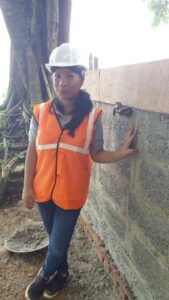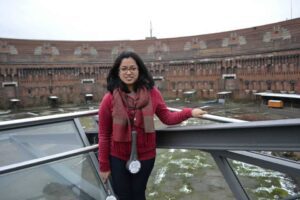Press for Progress: Female Architects as Creative Drivers of Post-Earthquake Reconstruction in Nepal
Build Change
Author
“Press for Progress” is our motto this month as we celebrate Women’s History Month. Women have always been a driving force behind human progress, and this month we celebrate their contributions to the world.
With their exceptional abilities to create, design, and transform, women are already at the forefront in the field of architecture. In Nepal, as elsewhere in the world, more and more women are entering this field. Moreover, they have been using their architectural skills to design earthquake-resistant houses after the devastating earthquakes of April 2015, and in the process have become creative leaders and drivers of safe reconstruction around the country.
So how are women architects contributing to reconstruction efforts in Nepal? What inspired and motivated them to be a part of the rebuilding process? What challenges have they faced and what are they learning on the way?
As we celebrate International Women’s Day on March 8, we bring to you inspiring stories from four young women architects who work for Build Change and are contributing to locally adaptable and affordable reconstruction.
Ayusha Joshi, Staff Architect

For Ayusha, architecture is about creating something permanent that has a positive impact on people. She chose to become an architect because she was always intrigued by how buildings could affect the way we live, our mood, and behavior. Through architecture, she strives to influence people’s lives for the better.
When the devastating earthquake hit Nepal in April 2015, Ayusha realized how she could use her skills to influence people’s lives by helping her country build back safer. She joined Build Change and started working in the remote earthquake-affected communities of Nepal. “As city dwellers, we spend the majority of our time in an urban environment and do not get to visit the remote communities of Nepal as often as we would like. Since there is such a difference between rebuilding in urban and rural environments, we need to develop a deeper understanding of rural communities and their rebuilding processes. This was the reason why I was quite excited when I got an opportunity to be a part of sustainable rural housing reconstruction process,” she says. Being an architect and working in a community is quite a different strategy. “It is very different from working with commercial clients in urban areas. We need to consider the homeowners’ needs and requirements, the local architecture and construction techniques, and the impact of the project on the community,” she says. Initially, it was quite challenging for Ayusha and other female architects and engineers in the field to earn the trust of local community members. While working in the rural community of Kaule of Nuwakot district, homeowners only talked to the male architects and engineers, as they believed that men know best. Why would they waste their time talking to women? Over time, this perception has changed. Now, more and more homeowners seek technical assistance from the female technical staff. This is all thanks to Ayusha and other female technical staff in the field for their dedicated efforts!
Ayusha’s pride in contributing to the safe reconstruction of rural Nepal is obvious. “The risks that I have taken have all been worth it.” She encourages other female architects to “take up the challenges that help us grow as professionals because architecture has many facets, and you never know what you will end up working on!”
Kriti Rajkarnikar, Staff Architect

Kriti always wanted to build her career in architecture, a field of both art and technology, where one’s art is materialized at real scale. It was during her undergraduate studies when she realized that architecture could touch people’s lives for better, which has turned into her biggest motivation. When the disastrous earthquake struck Nepal in 2015, Kriti was studying for her Master’s degree in Infrastructure Planning in Germany. In the immediate aftermath, she considered how she could use her skills and experience to contribute to the reconstruction efforts of Nepal. She returned to Nepal after finishing her studies and joined Build Change.
Kriti works within the technical team to design earthquake-resistant houses in rural areas, including both new construction and retrofits. She helped to establish the very first Technical Support Center (TSC) in Sindhupalchok district where she provided technical assistance and house design support to homeowners. “My work has given me a deeper insight into the local context of Nepal, as well as an opportunity to create social impact through architecture.” Outside of Kriti’s work for Build Change, she is also actively helping to save heritage architecture in Dhulikhel through research and documentation.
When asked about the challenges that women architects have to face, she says “it can be challenging at times for women to create their own identity in the construction industry.” But she believes that by showing sensitivity and perseverance, women will be able to prove that they can be leaders in the field of architecture. By expanding knowledge and pushing the boundaries of architecture, they can overcome any challenges.
Mansi Karna, Architect

“I tended to perceive architecture as a tool for the creation of a magical abode. To be an architect. to me, was to be a magician. The fantasy of a Utopian city, and the desire to create and inhabit one, became a driving force in my life and played an important part in my decision to go to architecture school,” says Mansi. It was not until she started working in the field of reconstruction however that she came to realize the huge gap between what is taught in colleges and what exists in reality. “Despite the college curriculum promoting architecture as a social art and luxury, I came to realize it was less about luxury and more about social need. After witnessing the massive destruction caused by poor housing quality during the earthquake, the need for safer housing became obvious.”
Mansi was the first architect at Build Change’s Nepal office, and she remembers how challenging it was for a single person to produce all drawings during the initial phase of reconstruction. However, she has been able to overcome these challenges with her driving passion for architecture and a supportive working environment. She says, “The best part of working here is the way Build Change encourages women architects, engineers, and other technical staff to contribute to decision-making discussions and provides an opportunity for us to become better at our job through continual professional development. Our work is valued equally as our male counterparts. So from where I stand, I can say that the future of women architects and engineers definitely appears to be bright. We just need to keep up our motivation and continue striving for more.”
Salina Pradhan, Staff Architect

“I chose to become an architect because I have always been attracted to homes, art, and interior design,” says Salina. Previously Salina had been working as a commercial architect designing houses for wealthy people in Kathmandu. “Now I have become a social architect, designing houses to address the needs and cost considerations of the rural communities,” she says.
Salina had always wanted to work in the field of rural housing and development, and she is glad that she is getting an opportunity to use her knowledge and skills to contribute to the reconstruction process in Nepal.
Regarding the challenges that women architects face, she says, “Although there are many female architecture students [in Nepal], when it comes to developing their careers they are constrained by their family and social responsibilities. In that sense, women architects are still relatively oppressed and it is difficult for them to take leadership roles within the field of architecture.” Salina believes that in order for women architects to excel professionally, they should always believe in their potential and should rise above social norms that constrain them to explore the limitless opportunities that architecture provides.
To Ayusha, Kriti, Mansi, Salina, and everyone supporting the national rebuilding- a big THANK YOU for your contribution and inspiration in driving the reconstruction process and for setting an example for the next generation in Nepal and around the world!
Support resilient housing worldwide
Join us in preventing housing loss caused by disasters.
Donate nowNewsletter
Sign up for our newsletter to receive updates on our latest news, events, and more.